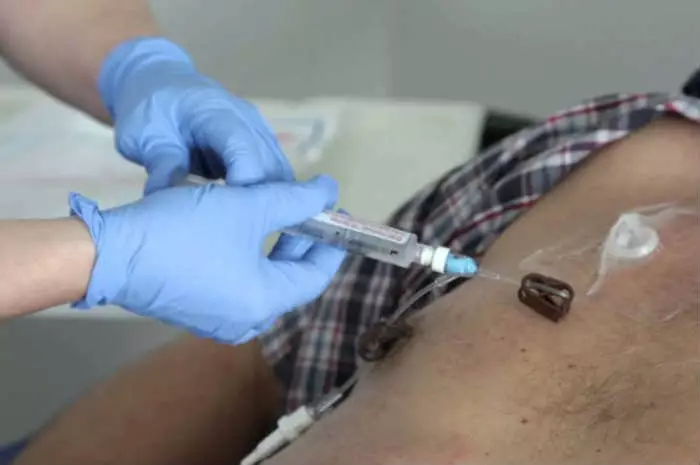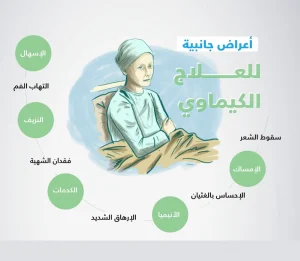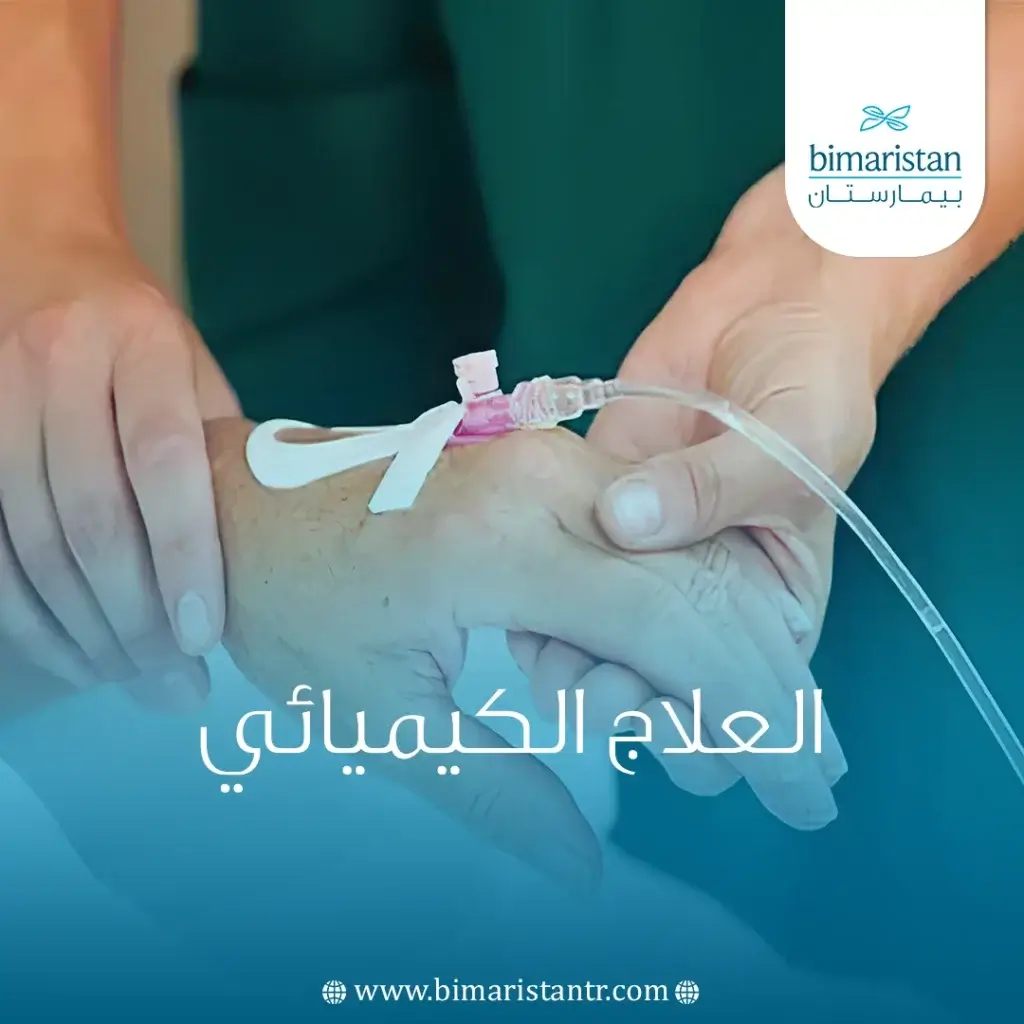يعتبر العلاج الكيميائي chemical therapy في تركيا أحد أهم العلاجات الفعالة التي تستخدم بشكل أساسي في علاج السرطان cancer treatment بجميع أنواعه ، بالإضافة إلى علاج مختلف الحالات الأخرى. كما أنه يستخدم لإعداد المرضى وتكييفهم لتلقي أنواع أخرى من العلاج مثل زراعة النخاع العظمي.
نستعرض في هذا المقال كل التفاصيل الخاصة ب العلاج الكيميائي ومجالات استخدامه وآثاره الجانبية وتفاصيل أخرى مهمة للمرضى الذين يذهبون إلى تركيا لتلقي هذا النوع من العلاج كالتكاليف و اﻹجراءات الطبية الجديدة المتبعة.
ماذا نقصد بالعلاج الكيميائي؟ chemotherapy treatment
يقصد به العلاج باستخدام الأدوية أو العلاج الدوائي و يهدف لتدمير و قتل البكتيريا و الفيروسات و الفطريات و الخلايا سريعة النمو في الجسم ك الخلايا السرطانية التي تنقسم بشكل أسرع من الأخرى.
غالبًا ما يستخدم مع أنواع أخرى من العلاج ، مثل الجراحة والعلاج الإشعاعي أو الهرموني. و هذا يعتمد على عدة عوامل منها:
- مرحلة و نوع السرطان لدى المريض و صحته العامة و رغبته الشخصية في اتخاد العلاج الأريح بالنسبة له.
- موقع الخلايا المسببة للسرطان.
ما الغرض من استخدام العلاج الكيميائي؟
العلاج الكيميائي أو الكيماوي chemical therapy هو دواء يتناوله المريض عبر الفم أو الوريد لينتشر في الجسم عبر مجرى الدم.
يستخدم العلاج الكيميائي أساسا لغرض التتقليل من الخلايا السرطانية destroy cancer cells و منه التقليل من احتمالية انتشار السرطان cancer. و كدا تصغير حجم الورم. كما يعمل على تقليل الأعراض الجانبية الناجمة عن أنواع أخرى من العلاج.
إذا كان الشخص قد خضع للعملية الجراحية لإزالة أي ورم سرطاني ، مثل استئصال الكتلة الورمية لسرطان الثدي ، فقد يوصي طبيب الأورام بهدا النوع من العلاج لضمان تدميرأي خلايا سرطانية متبقية سريعة النمو.
كما أنه يستخدم لإعداد المريض لتلقي العلاجات الأخرى كالعلاج الإشعاعي. أو يمكن استخدامه لتقليص الورم بحيث يتم إزالته جراحيًا، وفي حالة السرطان في مراحله المتأخرة ، قد يساعد العلاج الكيميائي على تخفيف الألم.
يمكن استخدام جرعات أقل بكثير من تلك المستعملة في علاج السرطان للمساعدة في الاضطرابات التي يهاجم فيها جهاز المناعة الخلايا السليمة ، مثل الذئبة (مرض جلدي) أو التهاب المفاصل الروماتويدي.
كيف يتم العلاج الكيماوي و كم يستغرق الوقت لذلك؟
في بعض الحالات قد يحتاج أي مريض السرطان لأن يخضع للعلاج الكيميائي قبل أو بعد العلاج بالأشعة أو قد يدمج العلاجين معا و عادة ما يتلقى العلاج الكيميائي في المستشفى أو العيادة, أو في منزله بعد تدريبه على أخد العلاج الكيميائي بالطريقة الصحيحة و في الوقت المحدد.
غالبا ما يعطى العلاج الكيميائي للمريض لفترة محددة, مثل 6 أشهر أو سنة. و يكون على عدة أجزاء كل بضعة أيام أو أسابيع، كما قد تكون هناك إجازة من العلاج لعدة أيام أو أسابيع أو حتى أشهر بينها. هذا الوقت المستقطع من العلاج يمنح الجهاز المناعي لمرضى السرطان الوقت الكافي لإعادة إنتاج خلايا سليمة جديدة وتقليل الأعراض الناجمة عن هدا النوع من العلاج.
يعتمد عدد الجلسات على:
- نوع ومرحلة الورم السرطاني.
- الغرض من العلاج الكيميائي.
- طريقة أخد العلاج الكيميائي (حقن وريدي أو عن طريق الفم،… إلخ)
- استجابة الجسم للعلاج. كلما كانت الاستجابة جيدة، كان عدد جلسات العلاج أقل.
الأدوية المستخدمة في العلاج الكيميائي drugs used to treat cancer
- أدوية وكلاء مؤكل Bio alkylating agents و تعرف بالعقاقير السامة للخلايا السرطانية , حيث تعمل على تثبيط نشاط تكاثرها و تؤدي بدلك لتدميرها.
يتضمن هدا النوع من العلاج الكيميائي عقاقير عبارة عن:
- مشتقتات غاز الخردل: السيكلوسولفاميد. الميكلوريثامين. الكلورامبيوسيل. اﻹفوسفاميد. و الملغان.
- ٳيثيلين أمين: ثيوتيبا و سداسي ميثيل الميلامين.
- ألكيل سلغوات: بوسولغان
- الأملاح المعدنية : أو أوكسالبلاتين. سيسبلاتين. و كاربوبلاتين.
- النتروزوز: الستربتوزوسين. لوموستين. كلرموستين
يتميز النيتروسوريس بقدرته على عبور حاجز الدم في المخ و يعتبر خيارا فعالا لعلاج أورام و سرطان الدماغ.
- عقاقير قلويدات النبات: Alkaloids تعمل على مهاجمة الخلايا السرطانية المنقسمة في مراحل مختلفة من دورة الانقسام.
و تشمل قويدات الفييكا. و التاكسادات, و البرودوفيلوتوكسين, و نظائر الكامبتوثيكان.
- Antimetabolites
يتضمن هدا النوع من العلاج الكيميائي مواد كيميائية تشبه في تركيبتها الكيميائية المواد الطبيعية الموجودة في الخلايا. تعمل على تثبيط و ايقاف انقسام الخلية السرطانية.
- مثبطات التوبويسوميراز: topoisomerase inhibitors
ٳنزيمات التوبوايسوميراز topoisomerase هي المسؤولة عن التحكم في المعالجة الهيكلية للحمض النووي في الخلايا. و تعتبر ضرورية في انقسام و تعدد الخلايا. تقوم هده المثبطات بتثبيط عمل ٳنزيمات التوبوايسوميراز داخل الخلية السرطانية.
كيف يتم ٳعطاء هذه الأدوية؟
يعطى العلاج الكيميائي (أدوية الكيماوي) بعدة طرق متنوعة منها:
-
العلاج الكيميائي عن طريق الفم
يمكن لمريض السرطان أخد بعض الأدوية الكيميائية عبر الفم في شكل حبوب أو كبسولات أو سوائل. و التي يمكن امتصاصها من طرف المعدة أو مباشرة من تحت اللسان. يحصل مرضى السرطان على أدوية الكيماوي من الصيدلية و يتناولونها في المنزل وفق تعليمات الطبيب المعالج . البعض من أدوية الكيماوي يتناول بشكل يومي، و البعض الاخر تعطى يوميًا لمدة 4 أسابيع تليها فترة راحة لمدة أسبوعين و هدا حسب ما يصفه الطبيب.
-
العلاج الكيميائي عبر الوريد
في بعض الأحيان يتطلب العلاج الكيميائي لمريض السرطان أخد الأدوية مباشرة بواسطة الحقن في الوريد. و يستغرق العلاج في هده الحالة من بضع دقائق إلى بضع ساعات. يمتص هذا النوع من الأدوية بسرعة في نظام الدورة الدموية في الجسم. تتضمن بعض أنواع الحقن الوريدي ما يلي:
– قسطرة الأوعية الدموية: يقوم الطبيب المعالج بإنشاء خط في الذراع أو اليد ويمكن أن يستمر حقن الأدوية لعدة دقائق إلى بضعة أيام.
–القسطرة المركزية المُدخَلة طرفيًّا PICC: تعتبر هده الطريقة مؤقتة ولكن يمكن أن تستمر من 6 أسابيع إلى بضعة أشهر. يقوم الطبيب بوضع القسطرة البلاستيكية الطويلة في أحد أكبر أوردة الذراع لمريض السرطان. يمكن القيام بذلك في المنزل عن طريق تثبيته بمضخة محمولة.
–القسطرة غير النفقية: تستخدم هده الطريقة كخيار قصير المدى في حالات الطوارئ. و تتم عن طريق الجلد ، يتم الوصول إلى الوريد الترقوي أو الوريد الوداجي و يمر الخط عبر الوريد الأجوف العلوي إلى الأذين الأيمن للقلب. تتطلب صيانة دقيقة وتغيير الضمادات بانتظام.
– القسطرة النفقية: تمر عبر منتصف الصدر ، لتتجاوز الخلايا تحت الجلد و تصل إلى وعاء الوريد الأجوف العلوي الذي يدخل الأذين الأيمن للقلب. يمكن أن تُترك هده القسطرة لسنوات مع فرص ضئيلة للإصابة بالعدوى. تعتبر خيار جيد في حالات العلاج المكثف مثل إجراء زرع نخاع العظم.
Port-a-cath- يستعمل كخيار دائم. و عادة ما يوضع بواسطة جراح أو أخصائي أشعة.يمكن أن يختلف عمره من ثلاث إلى خمس سنوات.

-
العلاج الكيميائي بالحقن:
يمكن إعطاء حقن الكيماوي في العضل أو حقنها تحت الجلد، و قد تتلقى هذه الحقن في الذراع أو الساق أو البطن.
– الحقن تحت الجلد:
تحقن الأدوية الكيماوية بواسطة إبرة قصيرة. تستخدم هده الطريقة لبعض معدلات الاستجابة البيولوجية وأدوية العلاج الكيميائي. إذا كانت نسبة الصفائح الدموية منخفضة، فمن غير المحتمل أن تسبب هذه الحقن أي نزيف أكثر من ذلك في حالة الحقن العضلي.
– الحقن الكيميائي العضلي:
بهده الطريقة, تحقن الأدوية بواسطة إبرة كبيرة مخصصة لهذا الغرض, حيث تخترق حقن الكيماوي طبقة العضلات حتى يترسب الدواء في أنسجة العضلات. لا تطبق معظم حالات العلاج الكيميائي عن طريق الحقن العضلي بسبب قوته على مرضى السرطان. كما لا ينصح الأشخاص الذين يعانون من انخفاض نسبة الصفائح الدموية بهدا العلاج بسبب احتمال حدوث نزيف داخل العضلات.
-
العلاج الكيميائي عبر الشرايين:
الشريان هو عبارة عن وعاء دموي ينقل الدم من القلب إلى جزء آخر من الجسم. في بعض الأحيان يتم حقن العلاج الكيميائي في الشريان الذي يذهب مباشرة إلى مكان السرطان. و هذا النوع من العلاج مفيد للمرضى المصابين بسرطان القولون وسرطان الأطراف وسرطان البنكرياس pancreatic cancer و سرطان المعدة stomach cancer.
-
العلاج الكيميائي الموضعي:
يمكن لمرضى السرطان تناول بعض أنواع الأدوية من ضمن العلاج الكيميائي في شكل كريم يضعه على البشرة ليتم امتصاصه. لا يستخدم هدا العلاج الكيميائي بشكل شائع جدا في علاج السرطان ولكنه يستخدم لعلاج سرطان الجلد.
-
العلاج الكيميائي داخل البطين:
تهدف الأدوية في هذا الإجراء إلى الوصول إلى السائل النخاعي لمريض السرطان. حيث أن الحاجز الدموي الدماغي يمنع العديد منها من الوصول إليه ، وبالتالي يمكن القيام بذلك بطريقتين؛ أحدهما هو البزل القطني والآخر هو خزان أومايا. يوضع جهاز مع قسطرة في الطبقة تحت الجلد على فروة الرأس. ثم يوصل إلى البطين الجانبي للدماغ. و توضع إبرة صغيرة من خلال خزان أومايا لحقن الأدوية. يعتبر هدا النوع من العلاج الكيميائي جيد لسرطان الدم.
-
العلاج الكيميائي داخل الصفاق:
في هذه الحالة، يمكن تصريف الدواء الكيميائي مباشرة في التجويف البطني لمريض السرطان ، و هو التجويف العام المحيط بالأعضاء. و هدا ما يجعل الأعضاء تغرق في الدواء قبل امتصاصها في موقع السرطان أو الورم.
-
العلاج الكيميائي داخل المفصل:
يستخدم هدا النوع من العلاج الكيميائي قسطرة بولية للوصول إلى المثانة البولية لمرضى السرطان. و يعتبر هدا النوع من العلاج مفيد للأشخاص الذين يعانون من سرطان المثانة الغازي السطحي.
-
العلاج الكيميائي داخل الجنبة:
تعطى أدوية الكيماوي في التجويف الجنبي للسيطرة على الانصباب الجنبي الخبيث ويستخدم لتخفيف أعراض السرطان كسرطان الرئة.
-
العلاج الكيميائي القابل للزرع:
يتم هدا العلاج بوضع رقاقة جلياديل في التجويف بعد إزالة الورم في المخ. يمكن تركها لمدة أسبوعين أو ثلاثة أسابيع للتأكد من أن جميع الخلايا السرطانية قد تم قتلها كليا في المنطقة المحيطة بموقع سرطان أو ورم الدماغ.
الأعراض الجانبية للعلاج الكيميائي sides effects of chemotherapy
يعمل العلاج الكيميائي على قتل و تدمير الخلايا سريعة الانقسام منها الخلايا السرطانية و الغير سرطانية. يمكن أن تتأثر هذه الخلايا سلبًا بالعلاج الكيميائي وهي متواجدة في: : الدم. الشعر. الجلد. بطانة الأمعاء و هدا ما يؤدي الى ظهور مجموعة من الآثار الجانبية. منها ما يلي:

- حدوث الكدمات والنزيف المفرط بسهولة
- الإسهال
- قرحة و جفاف في الفم
- تعب
- حمى
- تساقط الشعر
- فقدان الشهية taste
- الغثيان
- التقيؤ
- فقدان الوزن
- الألم
- الالتهابات
- فقر دم
- الإمساك
- الاعتلال العصبي
- مشاكل في الذاكرة و التركيز
- تغيرات في الجلد و الأظافر
- الأرق
- التغيرات الجنسية
تتوقف معظم هده الآثار الناجمة عن العلاج الكيميائي فور انتهاء العلاج.
ولكن هناك خطر حدوث تأثيرات طويلة المدى قد تظهر حتى بعد سنوات من العلاج الكيميائي، اعتمادًا على نوع العقاقير الكيميائية المستخدمة و التي يمكن أن تلحق ضررا بوظائف القلب و الكلى و الرئتين و الأعصاب و الأعضاء التناسلية.
ماذا بعد علاج السرطان كيميائيا؟
ستكون هناك متابعة طبية منتظمة أثناء وبعد العلاج الكيميائي لمرضى السرطان تحت اشراف طبيب خاص و فريق علاج السرطان ، وسيشمل ذلك اجراء فحوصات منها تقنيات التصوير ، واختبارات مخبرية ، وربما أكثر. يمكن للطبيب تغيير خطة العلاج الكيميائي في أي وقت وفق المعلومات و النتائج التي يشاركها مريض السرطان معه حول تأثير العلاج الكيماوي عليه. و هذا بإخبار الطبيب بأي آثار جانبية للعلاج أو مشاكل تتعلق بالعلاج الذي يتلقاه حتى يتمكن الطبيب من إقتراح حلول و إجراء تعديلات على العلاج إذا لزم الأمر.
أهم الأسئلة الشائعة حول العلاج الكيميائي
هل العلاج الكيماوي مؤلم؟
في الغالب تكون عملية العلاج الكيماوي غير مؤلمة، لکن قد يواجه المرضى آثارا جانبية مؤلمة بعد العلاج الكيماوي. يفضل أن يحصل الشخص علی معلومات کافية حول العلاج الكيماوي و طرق التعامل معه.
هل يزداد وزني بعد العلاج الكيميائي؟
يمكن أن يؤدي العلاج الكيميائي إلى زيادة الوزن بحيث: يجعل الجسم يحتفظ بالسوائل الزائدة ، والتي تسمى الوذمة. يسبب التعب و تصبح ممارسة الرياضة أمر صعب. زيادة الغثيان الذي يتحسن بتناول المزيد من الطعام.
ما هي الأطعمة foods التي يجب على مرضى العلاج الكيماوي تجنبها؟
توصلت دراسة أجريت على مرضى السرطان أن هناك مجموعة من الأطعمة يفضل على مريض السرطان تجنبها منها:
- الأطعمة الحارة والتوابل spicy foods (مثل الفلفل الحار والكاري ومزيج توابل الكاجون).
- الأطعمة الدهنية أو الدهنية أو المقلية.
- الأطعمة الحلوة والسكرية .
- وجبات كبيرة.
- الأطعمة ذات الروائح القوية (الأطعمة الدافئة تميل إلى أن تكون رائحتها أقوى).
- الأكل أو الشرب بسرعة.
ما هي تكلفة العلاج الكيميائي في تركيا؟
تترواح التكلفة المتوسطة للعلاج الكيميائي في تركيا من 600 دولار حتى 3000 دولارتختلف تكلفة العلاج الكيميائي في تركيا حسب: نوع السرطان و درجته. بالاضافة الى المدة المستغرق لعلاج الورم السرطاني. كما يمكن أن تزيد التكلفة عن دلك ادا كان السرطان في مراحل متقدمة.
كيف تتم الاجراءات لتلقي العلاج الكيميائي في تركيا؟
- سيكون لدى مرضى السرطان دعم طبي على الهاتف مجانا, و مسؤول يتتبع حالتهم الصحية, يستمع لاستفساراتهم و يقترح حلول للعلاج.
- يقوم الممثل الطبي لدينا بالتواصل مع الأطباء المختصين والمستشفيات في تركيا لإيجاد أفضل العلاجات الممكنة لحالتهم الصحية و بأقل تكلفة.
- نقوم بالتواصل مع السفارة التركية في بلد المريض لمساعدته في الحصول على تأشيرة الدخول الى تركيا لتلقي العلاج و ترتيب برنامج رحلته العلاجية مجانا .
- نقوم بترجمة الوثائق والتقارير الطبية للغة التركية مجانا نيابة عنهم.
- نقوم بمراقبة جميع مراحل علاج مرضى السرطان مجانا حتى نتأكد من فعالية العلاج المقدم لهم.
- قوم بحجز مكان السكن لهم ولمرافقيهم للعلاج في تركيا و كدا توفير خدمات المواصلات مجانا.
لمزيد من التفاصيل و المعلومات حول حالتك الصحية, لا تتردد بالتواصل مع أطباء بيمارستن من هنا..
